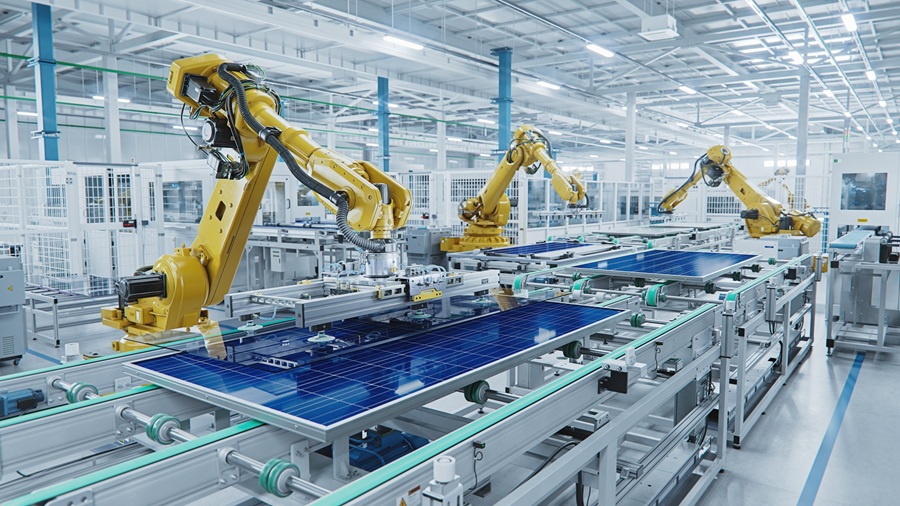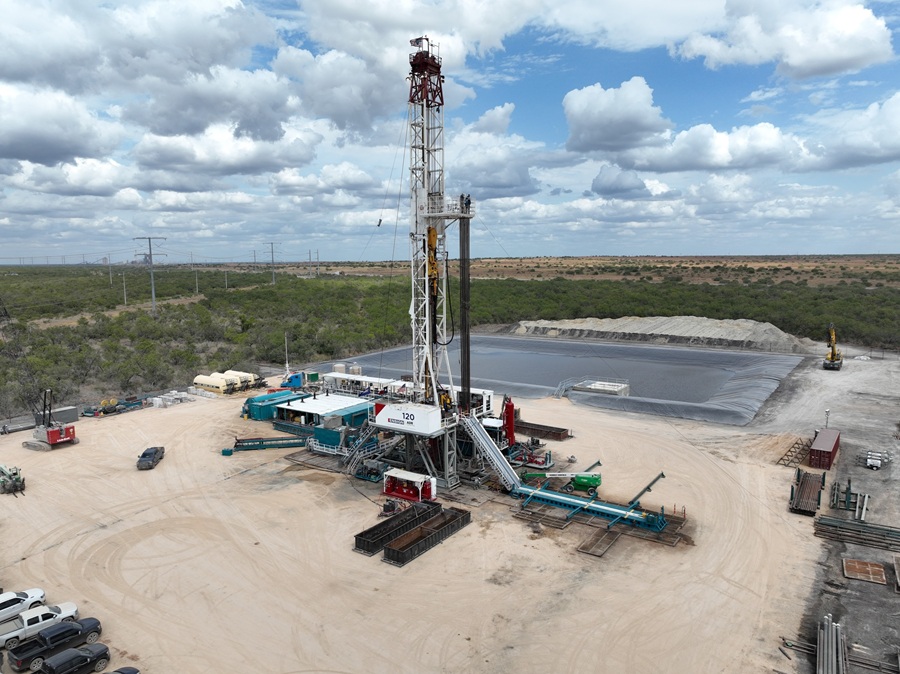
(Source: Hart Energy)
Bolstered by incentives in a bid to strengthen the U.S. solar supply chain, domestic solar manufacturers have reached 50 gigawatts (GW) of domestic capacity.
The Solar Energy Industries Association (SEIA) announced the milestone this week, saying the factories can meet all solar demand in the U.S. when operating at full capacity.
“Reaching 50 GW of domestic solar manufacturing capacity is a testament to what we can achieve with smart, business-friendly public policies in place,” said SEIA President and CEO Abigail Ross Hopper. “The U.S. is now the third largest module producer in the world because of these policy actions. This milestone not only marks progress for the solar industry but reinforces the essential role energy policies play in building up the domestic manufacturing industry that American workers and their families rely on.”

The solar industry has been reliant on other countries, mainly Southeast Asia, for solar panels needed for the nation’s growing solar sector. However, incentives created or expanded by the Inflation Reduction Act helped to make the U.S. a destination of choice for solar panel manufacturers looking to open new facilities and boost capacity.
Incentives include the advanced manufacturing production tax credit, which offers a per-unit federal tax credit for certain components domestically produced or sold by a manufacturer. Companies can also qualify for the advanced energy project credit for produced or recycled energy components like solar modules and for manufacturing facilities with equipment that lower greenhouse gas emissions.
Companies have announced plans for 56 GW of new U.S. solar cell production, 24 GW of wafers and 13 GW of ingots, according to SEIA’s Supply Chain Dashboard.
Here’s a roundup of some other renewable energy news.
Biofuels
Infinium, Summit Carbon Solutions Join Forces to Advance Efuels
Summit Carbon Solutions on Feb. 5 said it entered an arrangement with electrofuels (eFuels) producer Infinium for a supply of up to 670,000 metric tons of CO2 annually at a proposed eFuels facility in North Dakota or South Dakota.
The proposed facility would open more market opportunities for U.S. ethanol producers and farmers in the Midwest, Summit said in a news release.
“As demand for eFuels continues to rise, it is essential to secure reliable and scalable CO2 sources,” said Infinium CEO Robert Schuetzle. “Summit’s infrastructure would supply the CO2 needed to scale production and advance eFuels as a key part of America’s energy future.”
Made by combining captured CO2 with green hydrogen, eFuels are used in the aviation, shipping and heavy transport sectors.
“CO2 is a commodity with growing value, and Infinium’s eFuels technology is an important piece of the puzzle,” said Summit Carbon Solutions CEO Lee Blank. “By providing a reliable CO2 supply, we’re helping unlock opportunities that support domestic energy production and economic growth.”
RELATED
Gevo Completes $210MM Red Trail Assets Deal for Ethanol Plant
Energy storage
PotlatchDeltic Enters Lithium, Bromine Lease Agreement in Arkansas
Real estate investment trust PotlatchDeltic on Feb. 5 said it executed a lease agreement that gives Tetra Brine Leaseco exclusive rights to carry out brine exploration and production on land in Arkansas’ lithium-rich Smackover Formation.
The agreement covers about 900 surface acres in Lafayette County, according to a news release.
“We view the lease with Tetra as a great first step in demonstrating the lithium potential from our brine deposits,” said PotlatchDeltic CEO Eric Cremers. “We estimate we have 5,000 – 7,000 acres with lithium-bearing opportunities that are located within the higher-grade area in the Smackover Formation, where billions in future lithium-related investments have been announced.”
Several companies are working to develop lithium resources in the Smackover region. Though the formation spans from Texas to Florida, Arkansas has been a hotbed of activity. Lithium resources in Smackover brines of southern Arkansas could be between 5.1 MMtonnes and 19 MMtonnes, according to machine-learning estimates released in 2024 by the U.S. Geological Survey.
For the Tetra lease, PotlatchDeltic said it anticipates an initial five-year term for planning, engineering and construction before potential production begins. The lease provides for payments for the duration of the lease as well as future production payments for bromine and royalty payments for the profitable extraction of lithium, the release states.
Cremers said PotlatchDeltic is in talks with other parties about leases.
“We believe we are well-positioned to drive long-term value for our shareholders through all of our natural climate solution opportunities,” Cremers said.
PotlatchDeltic said it owns 2.1 million acres of timberlands in Alabama, Arkansas, Georgia, Idaho, Louisiana, Mississippi and South Carolina.
EDP Renewables Secures Land for Energy Storage Project in Canada
EDP Renewables (EDPR) Canada has secured land from the city of St. Thomas in Ontario, Canada, for a 75-megawatt (MW) energy storage project it is developing in partnership with Caldwell First Nation, according to a Feb. 4 news release.
Located within Caldwell First Nation territory, the Edgeware energy storage project was also awarded a 20-year contract with the Ontario Independent Electricity System Operator, EDPR said in the news release.
The land deal was sealed as energy storage and renewable development increase in Canada, which is diversifying its energy mix and targeting net-zero emissions.
“EDPR Canada is proud to be partnering with Caldwell First Nation and the City of St. Thomas on the development and success of the Edgeware project,” said Thomas LoTurco, executive vice president of Eastern U.S., Canada and government affairs at EDP Renewables North America. “The project will provide economic benefits locally while also supporting the reliability needs of the province of Ontario.”
Developers aim to begin commercial operations in 2027. Permitting is expected to be complete in 2025. EDPR Canada’s other Ontario operations include the 100-MW Nation Rise and 30-MW South Branch wind farms.
RELATED
CS Energy, Calibrant Deliver Three BESS in New York
Geothermal
Sage Geothermal, ABB Form Energy Storage, Power Partnership

Sage Geothermal, which inked a deal last year to provide geothermal power to tech giant Meta, has preliminarily partnered with ABB to develop low carbon energy storage and power generation, according to a Feb. 4 news release.
As part of the memorandum of understanding, ABB said it will support Sage’s agreement with Meta for the project east of the Rocky Mountains. ABB’s work scope will include investigating how its automation, electrification and digital technology can be deployed at geothermal sites to maximize energy efficiency and reliability.
“To be able to exploit the potential of geothermal energy to enable a low-carbon society, we need cross-industry collaborations to drive advancements in the technology,” said Per Erik Holsten, president of ABB Energy Industries.
ABB said it could also develop solutions for Sage’s energy storage technology. As explained in the news release, Sage’s Geopressured Geothermal Systems technology pumps fluid at pressure into a manmade subsurface reservoir. The stored water is then heated and released back to the surface using pressure or mechanical energy. From there, the water moves through heat exchangers and turbines to generate electricity.
“We are focused on scaling our proprietary Geopressured Geothermal Systems (GGS) technology and our partnership with ABB will advance the widespread deployment of next-generation geothermal,” said Sage Geosystems CEO Cindy Taff. “Unlike traditional renewable energy sources, geothermal solutions, including energy storage and baseload power generation, can provide an on-demand source of clean energy that is available 24 hours a day, 365 days a year.”
Sage agreed in 2024 to deliver up to 150 MW of geothermal energy to Meta to help meet growing data center electricity needs. The project’s first phase is expected to be operational by 2027, the release stated.
Hydrogen
Plug Power Launches Spot Pricing for Green Hydrogen

Plug Power has introduced a spot pricing program for liquid green hydrogen, marking an industry first, the company said Feb. 5.
The program gives buyers an opportunity to buy liquid green hydrogen from Plug’s production plants on-demand and without long-term take-or-pay agreements, the company said.
“Our pioneering spot pricing program is a testament to Plug’s commitment to customer-centric innovation,” said Plug Power CEO Andy Marsh. “By adapting to market demands in real-time, we are not only enhancing the accessibility and affordability of green hydrogen but also accelerating its adoption across various sectors.”
S&P Global Platts will publish a price on Thursdays for the following week based on Plug’s supply and demand at the current time, according to a press release. If customers want to purchase hydrogen at the published price, Plug will execute a transaction agreement to accept a customer tanker at one of its plants for a fill.
To participate, customers are required to have a spot agreement with the company. Plug said it has already entered such agreements with several industry players, including one of the largest industrial gas companies. The company was not named.
“Looking forward, the ripple effects of this innovative pricing model could redefine supply dynamics and cost structures across the entire green hydrogen ecosystem,” Plug said.
The company currently produces about 45 tons per day of liquid hydrogen from its facilities in Woodbine, Georgia, Charleston, Tennessee, and St. Gabriel, Louisiana.
RELATED
Plug Power CEO Sees Hydrogen as Part of US Energy Dominance
SkiesFifty, Catalsys Form Ammonia-focused Aviation Partnership
Investment fund SkiesFifty plans to create a joint venture (JV) with technology company Catalsys, aiming to decarbonize ground operations in the aviation sector.
SkiesFifty said the JV will utilize Catalsys’ green ammonia-fueled generator paired with a portable ammonia cracker, the fund said in a Feb. 5 news release. The technology, which has a modular and scalable design, enables constant reliable on-site production of green electricity from renewables—independent of grid connections, according to the release.
“The Catalsys technology offers a unique path to decarbonizing ground operations—an often overlooked yet vital part of a sustainable aviation ecosystem,” said Krishnan Narayanan, founding partner at SkiesFifty. “And beyond that, it shows enormous potential for alternative propulsion systems, and the most cost-effective hydrogen delivery that we have seen.”
The partnership will focus on ground operations decarbonization with Catalsys ammonia-cracking technology. The technology generates zero-carbon electricity for airside and landside operations where grid connections are limited. The companies will also explore alternative propulsion for aircraft converting green ammonia into a fuel blend compatible with jet engines.
RELATED
Exxon CEO Darren Woods: Hydrogen Incentives ‘Critical’ for Now
Solar
New York Approves Hecate, Greenbacker’s 500-MW Solar Farm
The New York Office of Renewable Energy Siting and Transmission (ORES) has given Greenbacker Renewable Energy Co. and Hecate Energy permission to begin construction of the 500-MWac Cider solar farm, according to a Feb. 3 news release.
The independent power producer, which purchased the solar project from Hecate in 2024, recently secured $950 million in financing for the project. The solar farm, being developed by Greenbacker and Hecate, is located on about a 2,500-acre site near the towns of Elba and Oakfield in Genesee County. It is expected to generate 920,000 megawatt-hours of electricity annually, which Hecate said is enough to power more than 120,000 New York households.
“As New York’s largest solar energy project, Cider Solar Farm will be instrumental in delivering reliable, emissions-free power to meet the state’s rising electricity demand," said Harrison Luna, project developer for Cider Solar Farm at Hecate Energy. "We are proud to work alongside Greenbacker in bringing this landmark project to life and contributing to a cleaner, more sustainable energy infrastructure for New York.”
ES Foundry Growths Solar Cell Production with New Facility
Solar cell producer ES Foundry recently marked the opening of its crystalline solar cell manufacturing plant in Greenwood, South Carolina, the company said Feb. 3.
The more than 400,000-sq-ft facility is expected to reach a shipment capacity of 3 GW by third-quarter 2025, ES Foundry said.
“We are not just celebrating a factory—we are forging a path to a more sustainable, energy-secure future for America,” said ES Foundry CEO Alex Zhu. “Our advanced solar cells are engineered and manufactured right here in the United States, ensuring reliability, efficiency and the opportunity to maximize financial incentives for our partners.”
The new manufacturing facility opened its doors as solar generation continues to grow in the U.S. The domestic production of solar cells also enables the company’s partners to unlock additional Investment Tax Credit benefits for domestic content, ES Foundry said.
“SEIA congratulates ES Foundry for opening this new facility, which will play a critical role in ensuring the United States is the dominant global solar manufacturing leader,” said Abigail Ross Hopper, president and CEO of the Solar Energy Industries Association. “This facility is an example of how we combine good policy with business innovation to deliver for American workers, support the local economy and strengthen our nation’s energy security.”
Premier Energies Pauses US Solar Cell Facility Plans Amid Policy Uncertainty
Indian solar modules maker Premier Energies on Feb. 3 said it will put its plan on hold to build a 1-GW solar cell manufacturing facility in the U.S., after newly elected President Trump ordered a pause on Biden-era green policies.
Premier and North American solar module maker Heliene had announced a joint venture in July 2024 to build a U.S.-based solar cell manufacturing facility to capitalize on the incentives and tax credits for domestic clean energy manufacturing under the Inflation Reduction Act (IRA).
In January, President Trump ordered a halt to spending related to climate and infrastructure laws from the previous administration, paused tax credits for clean industries and suspended new offshore wind power leasing. Simultaneously, he unveiled a plan to maximize U.S. oil and gas production and withdraw from the Paris climate agreement.
“We still have this plan ... We are waiting for the regime in the U.S. to settle down and be clear on what they want to do. As of now, we have only heard and read that the IRA has been paused,” Managing Director Chiranjeev Saluja said in an investor call.
“As a company, we have taken a conscious decision not to move ahead until we get full clarity on this topic,” he said.
Concerns over U.S. stance on clean energy have weighed on shares of Premier, which have lost about 23% since hitting a peak in December, after listing in September.
Rival solar module maker Waaree Energies told Reuters last week it is well-prepared to handle potential import tariffs under the Trump administration, leveraging its operations in the state of Texas.
EDPR NA Distributed Generation Completes Solar Farm in Maine
EDP Renewables North America Distributed Generation (EDPR NA DG) has completed construction of the 3.4-MW Bristol I community solar project in Maine, the company said in a Feb. 5 news release.
Power generated from the solar farm will go to more than 400 residential and small business subscribers in southern Maine who signed up to procure power from the project through EDPR NA DG’s partner PowerMarket, the release stated. Other project partners included developer Midcoast Solar and E&S Electric Co., which provided construction services.
“This [project] continues EDPR NA DG’s growth in the community solar sector, with more than 61 MWac [megawatt alternating current] of operating assets spanning 32 projects across six states,” the company said. “An additional 27 MWac of community solar projects are currently under construction.”
RELATED
TPG to Buy Solar Company Altus Power, Take Private in $2.2B Deal
Wind
Ørsted Slashes 2030 Investment Program By 25%
Denmark’s Ørsted decided to cut its 2030 investment program by 25%, the renewable energy firm said on Feb. 5, as the offshore wind industry grapples with rising costs and supply chain issues.
The firm will now invest in the range of 210 billion to 230 billion Danish crowns ($29.32 billion to $32.12 billion) for the period of 2024 to 2030, down from its previous target of 270 billion Danish crowns.
Ørsted also withdrew its previously set 2030 target for installed renewable capacity of 35 GW to 38 gigawatts, less than a week after replacing its top boss with a company insider Rasmus Errboe.
“We’ll reduce our investment program towards 2030 through a stricter, more value-focused approach to capital allocation. We do this to ensure a stronger balance sheet,” Errboe said.
The group has been crucial to establishing a European industry for wind at sea, but the industry has struggled in recent years and now faces challenges from U.S. President Donald Trump, who has raised opposition to wind power.
The cuts will not impact the group’s renewable projects under construction, Ørsted said, adding that it will be restructuring its workforce and reducing the pace of new construction.
The Danish renewable energy firm has struggled to unleash the potential of the U.S. offshore wind market and been forced to book several impairment charges. The company said on Feb. 5 its U.S. offshore wind portfolio has led pressure on its credit metric.
The company expects its EBITDA to increase to a range of 29 billion to 33 billion Danish crowns in 2026, excluding new partnerships and cancellation fees.
Ørsted’s woes reflect the changing fortunes of wind power globally as soaring costs, delays and limited supply chain investment prompt investors to reassess the speed of the energy transition.
New Jersey Will Not Award New Offshore Wind Contracts After Trump Order
New Jersey officials on Feb. 3 said the state would not grant awards for new offshore wind contracts, a sign that U.S. President Donald Trump’s order to review the federal offshore wind program is putting a chill on the industry.
The announcement by the New Jersey Board of Public Utilities comes days after Shell backed out as a partner in the only project that had finalized a bid under the state’s latest offshore wind procurement scheme.
In a statement, the New Jersey Board of Public Utilities cited both Shell’s withdrawal from the Atlantic Shores project and uncertainty regarding federal support for the industry.
“The board concluded that an award in New Jersey’s fourth offshore wind solicitation, despite the manifold benefits the industry offers to the state, would not be a responsible decision at this time,” Christine Guhl-Sadovy, president of the BPU, said in the statement.
The announcement is the latest in a string of recent blows to the nascent U.S. offshore wind industry, which has struggled with soaring costs, canceled projects and a high-profile construction accident.
Trump has cast doubt on the industry’s future after he suspended new federal offshore wind leasing pending an environmental and economic review, saying wind turbines are ugly, expensive and harm wildlife.
New Jersey is among the nation’s top offshore wind states. Governor Phil Murphy has a goal of installing 11,000 MW by 2040 as part of his agenda to boost clean energy and combat climate change.
In its fourth solicitation, the state had sought up to 4,000 MW of offshore wind capacity. The BPU said two of three bidders had withdrawn from the process, leaving only Atlantic Shores, a joint venture between Shell and France’s EDF.
Atlantic Shores received federal approval from the administration of former President Joe Biden last year. If built, the project is expected to be able to generate enough electricity to power 1 million homes.
RELATED
Costs for Dominion’s 2.6-GW Offshore Wind Project Swell to $10.7B
Hart Energy Staff and Reuters contributed to this report.
Recommended Reading
Enbridge Appoints Steven Williams to Chair of the Board
2025-03-12 - Enbridge has appointed Steven Williams to lead the board of directors following Pamela Carter’s retirement as chair.
BlackRock CEO: US Headed for More Inflation in Short Term
2025-03-11 - AI is likely to cause a period of deflation, Larry Fink, founder and CEO of the investment giant BlackRock, said at CERAWeek.
Baker Hughes to Supply Equipment for NextDecade’s Rio Grande LNG
2025-03-11 - Baker Hughes will provide turbine and compression for NextDecade’s trains at Rio Grande LNG.
Pearl Backs Haynesville Mineral and Royalties Firm Wild Basin
2025-03-10 - Equity commitments from Pearl Energy Investments and others have put $75 million of backing behind Haynesville Shale minerals and royalties company Wild Basin Energy.
Expand Energy Picked to Join S&P 500
2025-03-10 - Gas pureplay Expand Energy will be elevated on March 24 from its position in the S&P MidCap 400 index.
Comments
Add new comment
This conversation is moderated according to Hart Energy community rules. Please read the rules before joining the discussion. If you’re experiencing any technical problems, please contact our customer care team.






